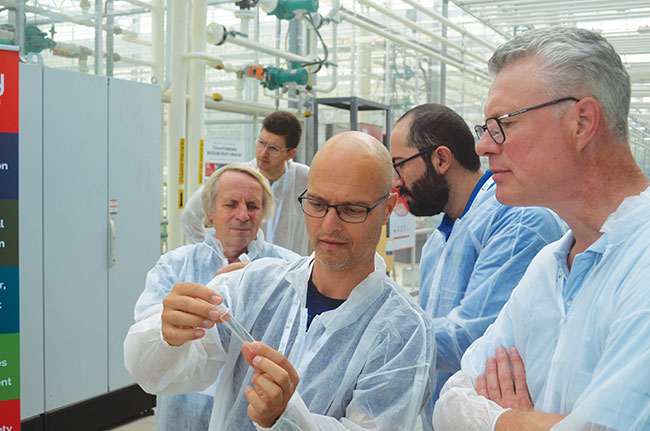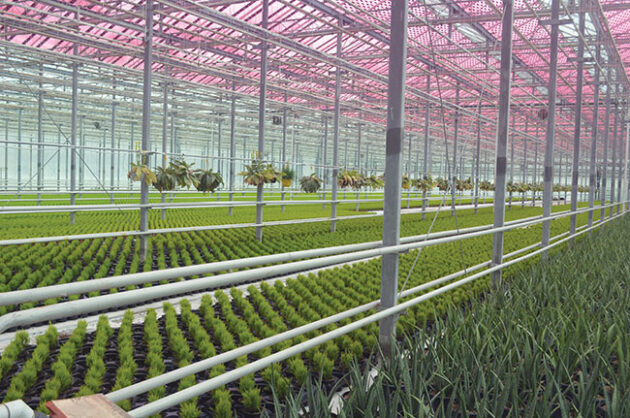
Features
2022 ToBRFV Research Symposium
2022 ToBRFV Research Symposium brings together researchers, growers and government officials from around the world in an effort to rid greenhouses of the destructive virus
October 11, 2022 By Andrew Snook
 Attendees check out an insect being researched for pest control applications at the Vineland Research and Innovation Centre.
PhotoS: Andrew Snook.
Attendees check out an insect being researched for pest control applications at the Vineland Research and Innovation Centre.
PhotoS: Andrew Snook. Leading experts from around the world came together in Toronto to discuss the Tomato Brown Rugose Fruit Virus (ToBRFV) this past August.
The 2022 ToBRFV Research Symposium drew more than 125 attendees to listen to 17 speakers present their latest research, technologies and industry updates from many areas of the world including Germany, the U.K., the Netherlands, Belgium, Israel, Jordan, the U.S. and Canada. The two-day symposium drew people from a wide-reaching audience that included research institutions, government, grower organizations, producers, propagators, seed companies, greenhouse suppliers, biocontrol companies, disinfectant/crop protection companies, laboratories, media and more.
The event was a collaboration between OMAFRA, Ontario Greenhouse Vegetable Growers, Ontario Fruit & Vegetable Growers Association, Flowers Canada (Ontario) and Agriculture and Agri-Food Canada; with support from the Canadian Greenhouse Conference organizers and Vineland Research and Innovation Centre.
The symposium kicked off with a session by Dr. Nida’ Salem, professor of plant pathology, Department of Plant Protection at the University of Jordan in Amman, Jordan.
Salem’s presentation, “Epidemiology and management of ToBRFV,” looked at the impact of the new tobamovirus infecting tomato crops in Jordan since 2015. She discussed how the virus can spread extremely quickly infecting up to 100 per cent of a crop and creating yield losses anywhere between 25 and 100 per cent. Common causes of the spread of the virus include infected seeds; direct plant-to-plant contact by greenhouse workers, tools and clothing; and bumblebees. Salem recommended control methods to limit the source of ToBRFV, which included using virus-free certified seed; avoiding repeating tomato crops; removing root debris and any plant residues; and before planting, carefully disinfecting the greenhouse, stakes and tools. Concerns about contaminated seeds came up several times during the two-day symposium.
One of the most startling presentations where contaminated seeds were highlighted was presented by Dr. Michael Bledsoe, vice-president of food safety and regulatory affairs for Village Farms International for U.S. and Canada.
During his presentation, “Update on the North American Greenhouse Industry and Impact of the USDA/APHIS Federal Order,” Bledsoe discussed how Village Farms tests seeds before propagation – a common practice by many greenhouse operations.
In 2018, after learning of ToBRFV, the company added testing of tobamovirus/ToBRFV to its seed tests performed by CSP Labs in California. In 2019, Village Farms added genetic sequencing to its tobamovirus PCR positives to confirm ToBRFV, with secondary labs used for confirmation of the first lab’s positives.
During the testing of one supplier’s seed lots in 2019, four of 30 seed lots (just over 13 per cent) sent to Village Farms tested positive for ToBRFV by PCR, confirmed by a second lab through generic sequencing.
“None of those were propagated or planted, but that’s a pretty significant number,” Bledsoe said.
Village Farms have sent notices to tomato seed companies and seed suppliers notifying them that every shipment of seeds must be accompanied by seeds that would be sent for testing at CSP Labs for a variety of seedborne pathogens including tobamovirus (TMV, ToMV, and ToBRFV).
“Until seeds and propagation are free from virus, it’ll get in the greenhouses,” Bledsoe said.
The challenges of managing mechanical spread and building up virus resistance were also discussed in great detail by many presenters. Presentations related to disinfection and resistance included:
- “Application of disinfectants to manage the emerging ToBRFV in greenhouse tomato” by Dr. Kai-Shu Ling;
- “Cleaning of ToBRFV from contaminated clothing of greenhouse employees” by Jens Ehlers;
- “Genetic resistance and ToBRFV” by Dr. Jonathan Griffiths; and
- “ToBRFV: Turning Challenges into Opportunities” by Dr. Aiming Wang.
 There were also a variety of other presentations of great interest to attendees including one by Dr. Adrian Fox, who discussed “The battle against ToBRFV in the U.K.”; Dr. Ziv Spiegelman’s discussion on how ToBRFV overcame the durable Tm-22 resistance gene; Dr. Aviv Dombrovsky’s presentation on “ToBRFV and PepMV Current status and Future perspectives”; and Heike Scholz-Döbelin’s discussion on the experience with ToBRFV in Germany related to infestation, eradication, and prevention.
There were also a variety of other presentations of great interest to attendees including one by Dr. Adrian Fox, who discussed “The battle against ToBRFV in the U.K.”; Dr. Ziv Spiegelman’s discussion on how ToBRFV overcame the durable Tm-22 resistance gene; Dr. Aviv Dombrovsky’s presentation on “ToBRFV and PepMV Current status and Future perspectives”; and Heike Scholz-Döbelin’s discussion on the experience with ToBRFV in Germany related to infestation, eradication, and prevention.
The symposium also offered a variety of industry updates from representatives of the Canadian Food Inspection Agency; Serecon Inc.; Harvest Genomics; Walker Environmental; A & L Laboratories Inc.; Enza Zaden, the Netherlands; and Scientia Terrae and DCM, Belgium.
The second day of the symposium also offered attendees an opportunity to tour several facilities in southern Ontario, including the Landscape Ontario Horticultural Trades Association’s flower variety trial at its headquarters in Milton, Ont.; a stop at Beverly Greenhouses in Watertown, Ont. to check out the company’s cucumber growing and packaging operations; and a tour of Freeman Herbs in Beamsville, Ont., which grows more than 100 varieties of herbs. The final stop offered a tour of the Vineland Research and Innovation Centre followed by a wine tasting at Foreign Affair Winery.
Look for detailed articles on some of the ToBRFV Research Symposium presentations in future issues of Greenhouse Canada.
Print this page